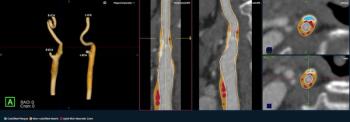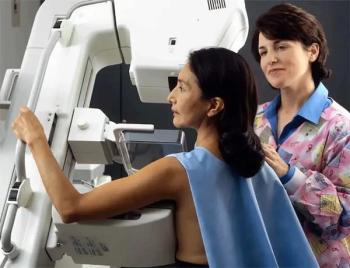
Study: AI Improves Cancer Detection Rate for Digital Mammography and Digital Breast Tomosynthesis
Comparing year-long findings with and without adjunctive artificial intelligence (AI) at a breast cancer screening program in Spain, researchers found the combination of digital breast tomosynthesis and AI had a 92.5 percent accuracy for diagnosing cancer in patients with elevated risk.
The use of adjunctive artificial intelligence (AI) doubled the positive predictive value (PPV) of digital mammography (DM) exams overall and led to greater than 90 percent accuracy for DM and digital breast tomosynthesis (DBT) in detecting breast cancer in women with elevated risk, according to research findings presented recently at the European Congress of Radiology (ECR) conference in Vienna, Austria.
For the
The researchers found the combination of AI and DM had an overall cancer detection rate of 8.1/1000 in comparison to 5.1/1000 for DM alone and had an accuracy rate of 95.1 percent for detecting malignancy in patients with an elevated risk for breast cancer. Adjunctive AI also doubled the overall positive predictive value (PPV) for DM (12.2 percent) in comparison to DM alone (6.1 percent), according to the study authors.
For patients with DBT and AI, the researchers reported a cancer detection rate of 9.6/1000 and a PPV of 16.5 percent in comparison to 5.8/1000 and 13.1 percent, respectively, for DBT alone. For the elevated risk group, the study authors said the combination of DBT and AI correctly diagnosed 92.5 percent of breast cancer.
“Artificial intelligence as support for readings in breast cancer screening practice increases cancer detection rate and positive predictive value for both DM and DBT,” noted Esperanza Elias Cabot, MD, who is affiliated with the Breast Cancer Unit in the Department of Radiology at the Hospital Universitario Reina Sofia in Cordoba, Spain.
(Editor’s note: For related content, see “
Dr. Cabot also noted a 1.7 percent decrease in the recall rate with adjunctive AI and DM (6.6 percent) in comparison to DM only 8.3 percent). She also pointed out 1.4 percent increase in the recall rate for DBT and AI (5.8 percent) in comparison to DBT alone (4.4 percent).
Of the four lesions missed by AI/DBT but detected by radiologists in the high-risk group, Dr. Cabot said two were invasive carcinomas with architectural distortion and the other two were invasive ductal carcinoma masses. Two lesions missed by AI/DM in the high-risk group included an invasive ductal carcinoma mass and a ductal carcinoma in situ with architectural distortion, according to the study.
Reference
1. Cabot EE. Artificial intelligence (AI) improves breast cancer screening performance for both digital mammography and digital breast tomosynthesis. Presented at the European Congress of Radiology, March 1-5, Vienna, Spain. Available at:
Newsletter
Stay at the forefront of radiology with the Diagnostic Imaging newsletter, delivering the latest news, clinical insights, and imaging advancements for today’s radiologists.






























